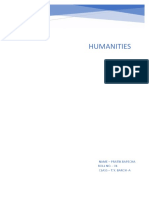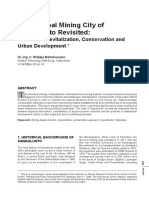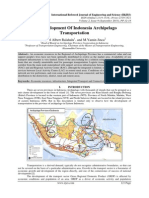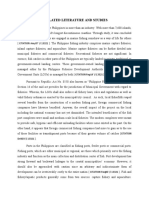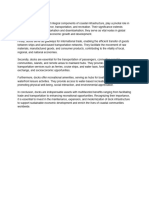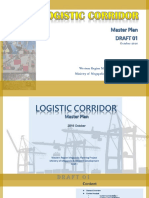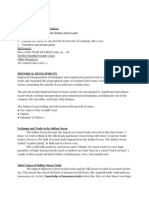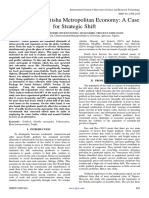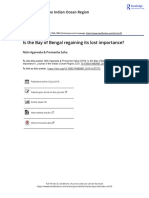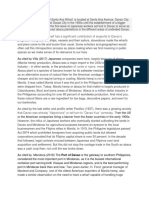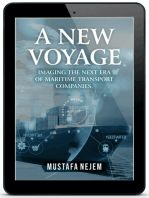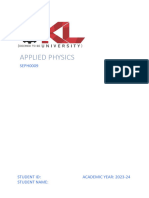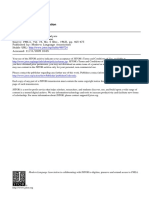Professional Documents
Culture Documents
Inter-Island Maritime Trade Dynamics and The Role of KPM of Sulawesi at The Beginning of The 20th Century
Original Title
Copyright
Available Formats
Share this document
Did you find this document useful?
Is this content inappropriate?
Report this DocumentCopyright:
Available Formats
Inter-Island Maritime Trade Dynamics and The Role of KPM of Sulawesi at The Beginning of The 20th Century
Copyright:
Available Formats
Volume 7, Issue 11, November – 2022 International Journal of Innovative Science and Research Technology
ISSN No:-2456-2165
Inter-Island Maritime Trade Dynamics and the
Role of KPM of Sulawesi at the Beginning of the
20th Century
Nahdia Nur1
Hasanuddin University, Indonesia
Abstract:- The southern part of Sulawesi played a very network. In addition, there is also a north-south trade
important and significant role in forming trade networks network, that is, shipping in this network is centered on
and economic integration between the 1900s and 1930s. Chinese maritime trade (Poelinggomang, 2004).
Dynamics, change, and development are the main
subjects of this research. This research aims to 1) reveal Developments and new trade centers, free trade policies
the dynamics of inter-island maritime trade and the role and the use of ships in the maritime world also have broad
of KPM in Sulawesi, early 20th century, and 2) inter- implications for shipping lanes and trade networks in
regional economic development activities in southern Sulawesi. Trade network activity in this region is through
Sulawesi, early 20th century. This research used rivers and seas centered on the coast and ports. The port
qualitative method. The result of this research is revealing which refers to the economic concept, it has function as a
the dynamics and development of maritime trade in South center for exchanging goods or for the entry and exit of trade
Sulawesi at the beginning of the 20th century. The free goods. Indigenous seafarers who still play an important role
trade policy that was implemented to a certain extent was in indigenous boat shipping amidst the expansion of
able to increase trade enthusiasm, especially in the steamships are the Bugis, Makassarese, Mandarese and
southern part of Sulawesi. The Dutch Government's Butonese (Murphey, 1989). Their area of operations is very
political intervention was quite flexible since the early broad, covering almost all regions and ports in the
20th century, making it easier for it to develop new archipelago. The boats of these native traders could anchor at
economic policy directions. Local elites were successfully all ports of the Dutch East Indies. This gives flexibility for
exploited in realizing economic networks and integration. Bugis-Makassar ships to conduct shipping and trade. Ports in
Thanks to the government's transportation capability, the Sulawesi region have become lively again as indigenous
through its Shipping Companies (KPM), the main routes shipping networks in the regions and in remote parts of the
of trade can be controlled as well as being able to control interior (Saleh, et al., 2021).
the movement of trade commodities. Moreover, Makassar
serves as a transit and storage center for various trading Furthermore, an inland area will have a functional
commodities, both for shipments outside Makassar, as relationship, either directly or indirectly with the port. In
well as various goods that will enter this area. This Dutch other words, for inland areas, ports function in offering
economic policy allowed it to explore existing economic trading volume to attract ships for trade from and to the
resources and channel them through controlled channels. interior. According to Broeze (1986), the main impact of a
port's activities is the economic field, which makes the
Keyword:- Trade Network, Makassar, Economic Integration, location of a port explain the regional hegemony network
Commodities. over interconnected cities. One of the variables of the
economic activity of a very important port is trade. The trade
I. INTRODUCTION will develop or not, determined by the role played by traders,
especially the role of intermediary traders between regions,
A. Background of study both individually and in groups with buyers (Lapian, 1975;
Indonesia's territory is divided into maritime trade Andini., et al, 2021). Trading activity takes place is a social
zones, namely, the northern and western coastal areas of phenomenon in an economic activity so this research is
Sumatra and they are included in the Malacca Strait trade important to do because it will reveal the dynamics and
zone, while the rest are classified as the Java Sea trade zone. development of trading activities in South Sulawesi in the
According to Hall (2019) that around the 14th century and the 20th century (Tahir , et al., 2018).
beginning of the 15th century, maritime trade zones
(commercia Izones) had formed in Southeast Asia. Basically, B. Theoretical Review
every trade network has a specific pattern of development of The study of the history of trade and economic
the exchange of trade products. These trading patterns will be integration is a network that has been built for a long time.
divided into five trading forms, 1) inside trading, 2) foreign According to Dick (1989) a maritime economic study that
trade, 3) third, trading with boats, 4) trading with canoes and sees the importance of trade networks in forming islands in
5) trading using animals, such as cows, buffaloes and horses. the archipelago. The trade network of ethnic groups through
However, trade relations also took place between these the main media has used sailboat transportation, and it
trading networks. East-West trading network and vice versa supports the formation of a trade network (Aslanian, 2014).
by placing the network closely related to the spice trading In the early 20's in the Dutch East Indies, traders who used
IJISRT22NOV1500 www.ijisrt.com 1261
Volume 7, Issue 11, November – 2022 International Journal of Innovative Science and Research Technology
ISSN No:-2456-2165
sailboats had formed ethnic group solidarity and played a and it formed the foundation for post-war economic
very important role in dealing with the KPM monopoly, with development.
the spirit of solidarity, ethnic traders such as the Bugis,
Makassar, Buton and Madurese made them survive on the Several aspects of Asian entrepreneurship have recently
voyage and even controlled shipping places that were not received attention, for example the importance of informal
reached by the KMP. overseas networks of Chinese emigrants. The development of
the domestic market was important for the integration of the
In addition, the inefficiency in the field of inter-island Archipelago and was largely a consequence of native export
shipping which took place in a very complex integration production. European plantations, agricultural or mining
context, and the crisis that occurred in the process of inter- companies had direct foreign links and were not dependent
island shipping stemmed from the conditions that were built, on local trade networks. Farmers who become active in
preserved and abandoned by the Colonial Government (Dick, agricultural exports interact with the wider economy of the
2006; ).(Hasnia, et al., 2022). archipelago. Colonial economic integration was enhanced by
Asian trade networks and it is fair to say that, outside of Java,
In line with that, Italiane (1986) in the Traditional colonial state formation lagged behind, but driven by the
Trading Networks of Southeast Asia, defines the notion of a expansion of exports abroad more coherent national economy
trading network, 1) there is a trade network between an ethnic was developing (Nahdhiyah et al., 2022).
group that is formed, due to trading activities between
regions, or between the same religious groups, not because of In describing this new discourse, Broek (1942) relates
the trade that was encouraged because of the emergence of to the emerging economic problems, between 1929 and 1939,
trade alliances. 2) A trade network formed due to ongoing the ratio of the value of trade between Java Island and areas
trade alliances able to form an existing trade network route outside Java to the value of foreign trade increased from 12%
and third, it is a trade network that can occur due to changes to 17%. The value of trade between the island of Java and the
in the trading network, which occur at any time, whether due regions outside Java has declined compared to the value of all
caused by production systems, markets, or because of the foreign trade, namely only one-third compared to the decline
emergence of new transportation (Evers, 1988; Sugiyartati, et in foreign trade. According to Broek (1942) the world crisis
al., 2020). marks the end of a period of growth, not only for economic
development, but also for economic policy. Economic
In terms of the network, when it is related to this nationalism increased and fostered a belief in free trade that
research, the network of production and export commodities was unsustainable for the government to change the course of
that exist in South Sulawesi is analyzed through several its economic policies.
meanings covering the areas of production of commodities in
the Greater East region. Commodities coming from these On the other hand, in the southern part of Sulawesi could
remote areas were immediately brought to other areas and did be like Boeke (1953) states that economic dualism, that the
not eliminate the boundaries of island territories for these Dutch East Indies society presented two separate faces from
commodities, but reached groups of islands and their network one another, both are rural communities who live simply with
to the world market (Kadir, 2018).The production areas an economy to meet their own needs and urban communities
include Palopo, Selayar, Balangnipa, Siwa, Bantaeng, dominated by European (Western) elements who live in
Watampone, Majene, Bau-bau, Kendari, Buton, Pallima, luxury with an advanced economy. In conclusion, the first is
Sinjai, Bonerate, Selayar, Bulukumba, Bantaeng and Maluku. static and difficult to develop and the second is dynamic.
Furthermore, the production was sent to other areas, Furthermore, he stated that the population of the Dutch East
including Makassar, Ampena Bali, Buleleng, East Indies had a wider need for protection because of the dualistic
Kalimantan, Surabaya, Singapore and others is exported and nature of the Dutch East Indies society, so that more and more
these commodities emphasize inter-inland, inter-regional, native people were cornered. Boeke saw the crises of the
inter-island, inter-port and inter-world market networks. 1930s as cutting and dualistic economic policies much
needed in the long term.
In this regard, Jeroen's study "The Colonial
Interregional Trade in Indonesia, 1900-1940: Serving In this regard, Creutzberg (1915) emphasized in four
Overseas Markets, Favoring Integration Into A Colonial editions which contain source material on economic policy in
State" writes that the interaction of Indonesian and Chinese the Dutch East Indies. Many topics are relevant in providing
entrepreneurs has become very important for the Indonesian an overview of economic policies during the 1900-1942
economy. In the post-war growth economy fueled by exports periods. There are five aspects of economic policy chosen to
and consciously pursuing industrialization, Asia's trade be discussed in emphasizing the development and nature of
mechanisms plays an important role, even with all the this policy, namely welfare politics, the rice problem,
problems of divisions between ethnic groups and their industrialization as a substitute for imports, the recession of
different economic roles (Jeroen, 2005). The role of Chinese 1919-1921, and the depression of the 1930s.
traders through stimulating local entrepreneurship,
distributing imports, and acting as credit bankers, Paauw (1963) revealed that during the 1930s the growth
intermediary trade networks were important in the increasing of inter-island trade was only an economic recovery in 1929
cohesion of the pre-war Indonesian economy. The strong because inter-island transport was only slightly higher than in
development of the Asian trading sector in colonial Indonesia 1920. The growth rate of cargo local private commodities
IJISRT22NOV1500 www.ijisrt.com 1262
Volume 7, Issue 11, November – 2022 International Journal of Innovative Science and Research Technology
ISSN No:-2456-2165
transported by KPM only increased by 13% during that Makassar was also declared to have trade relations with the
decade, at a growth rate of approximately 1.5% a year (Booth Portuguese in Malacca (Pires, 1991).
et al., 1988)
Even though the influence of the Dutch East Indies
The most important thing from the existing analysis is government was not strong before the end of the 19th century,
the theory of trade networks will be used to analyze networks South Sulawesi was already connected with world activities,
and trade in this part of South Sulawesi (Italiane, 1986). This in which exported commodities penetrated European
theory emphasizes the mechanism of exchange of goods, both markets. Then South Sulawesi returned to get new
on a small scale and across geographic areas, as stated by enthusiasm with the development of the economics of coffee
Lindblad (1998) that the outside economy increased rapidly and coconut trading materials. At this time colonial expansion
in the early 20th century due to its integration with the center had been launched in the islands which had an impact on the
of the world. development of road facilities to the interior areas. This
situation seems to encourage the development of traders, the
II. RESEARCH OBJECTIVE widespread use of money and the emergence of markets to
remote rural areas. In inter-island trade, ports, the KPM
This study aims 1) to reveal the dynamics of inter-island shipping organization played a very important role which
maritime trade and the role of KPM in Sulawesi, early 20th integrated with the Dutch colonial expansion in the islands,
century, and 2) to analyze inter-regional economic activities all of this brought changes in trade patterns. Therefore, under
in southern Sulawesi, early 20th century. the supervision of the Dutch East Indies Government, each
port in its network of trading centers had different variations.
III. RESULT AND DISCUSSION For example, how the population's economy develop, groups
of traders and inter-island traders took place before and after
A. Trade in South Sulawesi receiving influence from the KPM network in the islands.
There are three integrated livelihood sectors in
Sulawesi, namely agriculture, shipping and trade. These three This network system provides an indication that the
areas supported the people's economy, especially in South development of ports in this region is the center of
Sulawesi, when Bugis, Makassar, Javanese and Malaccan commercial activities which is determined by several factors,
traders expanded their search for trade materials to areas in including its strategic location and its position in the middle
southern Sulawesi and had an extraordinary impact on the of the world of trade. Then the intervention with the arrival
development of the trade network at Makassar Port (Jeroen, of the Europeans provided opportunities for traders and
2005). One of the factors makes Makassar Port very strategic shifted their activities to Makassar. This is coupled with the
and visited a lot because Makassar is a trade center in the role of residents in other areas as traders and sailors who
Greater East Region. Most of the commodities are exported make voyages to other production areas and trading ports
through the Port of Makassar and the trading activity is using boats and ships.
increasing with the arrival of traders from other areas
(Poelinggomang, 2022). Bugis-Makassar traders also sailed Meanwhile, trading activities in several coastal cities in
on trade voyages, with other trading centers all the way to Southeast Sulawesi, such as the port cities of Bau-Bau, Raha,
Australia. Kendari, and Kolaka, serve as a collection point for
commodity products that are traded at certain times.
Since the 19th century, trade relations with other regions Southeast Sulawesi's economic development in the early 20th
and areas have made Makassar have an important function in century was dominated by agriculture, trade and shipping.
commodity trading. Commodities are shipped from Makassar This is what supports the economy of the people of Southeast
to other areas and create trade contact routes with the outside Sulawesi in supporting the exploration of economic resources
world as well as creating important traffic in Makassar such as intensification of agriculture, plantations, opening of
(Poelinggomang, 2004). There are three defined routes, mines. This area is also visited by many ships, especially the
namely 1) Surabaya-Makassar-Amboina-Banda-Buru- KPM ship. KPM's ship network includes Pare-pare, which
Bacan-Ternate-Gorontalo-Manado-Amarung-Tolitoli- has transported rice originating from the interior of South
Parepare-Makassar and Surabaya, 2) Makassar-Bantaeng- Sulawesi and to several ports in Sulawesi, Maluku as well as
Bulukumba-Selayar-Sinjai-Palopo-Buton-Kendari-Makassar East Kalimantan. Traders who are oriented to inter-island
and returns via the same route and, 3) Makassar-Bima- trade can use the sailing boats in this area and have also
Nangamessi-Sabu-Rote-Kupang-Atapupu-Larantuka- contributed to the smooth transportation of commodities, in
Maumere-Bima and back to Makassar. which spice commodities that must be handed over to the
Dutch government are paid at a set price and benefit it
This policy of expanding trade relations succeeded in (Andini et al., 2022).
realizing the goal of positioning Makassar as the only trade
center in the region. It gave rise to power as the thriving B. Economic Activity
maritime kingdoms controlled trade. Bugis, Makassar, There are two major centers of economic activity in
Selayar, Malay and European traders and sailors who made South Sulawesi. One is in a market under Dutch colonial rule,
commercial voyages made Makassar a port of call. The and the second is in the Port of Makassar. Goods from all over
production market also establishes relationships with other the Indian Archipelago were transported in both places. This
trading ports located in the East, South, West and North parts. trading network has a relationship with the economic area
IJISRT22NOV1500 www.ijisrt.com 1263
Volume 7, Issue 11, November – 2022 International Journal of Innovative Science and Research Technology
ISSN No:-2456-2165
controlled by the Dutch government in the north of Makassar IV. CONCLUSION
and the area around the capital of the Dutch power. This trade
also involved several kingdoms that still held autonomy The progress of trade in the Sulawesi region especially
rights based on the Bungaya Agreement, namely the Makassar, cannot be separated from the launching of the Port
Kingdoms of Wajo, Sidenreng, and Bone (Mappangara, of Makassar as a taxpayer port. There were two centers of
2017). economic activity at that time, one in the market which was
under Dutch Colonial rule, and the second was in the Port of
Makassar's main trade is not only rice but also copra. Makassar. The Dutch East Indies government led traders to
Copra which is processed into oil is the most salable stop at this port which was used as a trading center. This
commodity in the world market. Because of this, in 1917 the progress is also supported by the presence of KPM which has
copra storage warehouse was expanded by about two a broad reach. Small ports that were not reached by KPM
kilometers to the exit from the Port of Makassar, namely, in became land for native traders whose space for movement
Kampung Maroangin near Poetere. This copra warehouse became narrower with the declaration of the Port of Makassar
expansion signals that OFI Makassar has grown. This is as a taxpayer port since 1906. Apart from that, trading
because the oil produced by OFI continues to grow from year activities also took place on land. The traders reach areas that
to year, and in purchasing copra OFI has the support of the produce export production, along with the transportation
Makassar branch of Javasche Bank and at least the Javasche system that is getting better.
bank issues f.1,500,000 credit each month to entrepreneurs
(Asba, 2008). REFERENCES
Apart from the coconut oil produced by OFI Makassar, [1]. Andini, C. Yassi, A, H., Sukmawaty (2021). The Use of
coconut oil is also circulating in the people of South Sulawesi. Honorifics in English and Buginese with special
Coconut oil specially made by local people. In the interior of Reference to Bone Language: A Comparative Study.
South Sulawesi, people prefer to use homemade coconut oil International Journal of Innovative Science and
because it smells good if it compared to factory-made coconut Research Technology, 6(7), 873-877.
oil. Nevertheless, based on OFI Makassar's annual report, it [2]. Andini, C., Sosrohadi, S., Fairuz, F., Dalyan, M.,
often covers the shortage of local oil needs of around 300- Rahman, F. F., & Hasnia, H. (2022). The Study of
7000 cans for months. Japanese Women in the Facial Treatment
Advertisement: A Semiotics Perspective of Pierce’s
In 1929 due to the economic depression, trading activity Theory. ELS Journal on Interdisciplinary Studies in
in Sulawesi decreased, and almost all economic powers Humanities, 5(2), 337-347.
weakened. According to Djojohadikusumo (1998) the [3]. Aslanian, S. D. (2014). From the Indian Ocean to the
economic depression was triggered by falling stock prices as Mediterranean: the Global Trade Networks of
a result of excessive speculation on the American capital Armenian Merchants from New Julfa (Vol. 17). Univ of
markets in October 1929. This condition led to the California Press.
contraction of the American and European macroeconomics [4]. Asba R. (2008). Makassar Kekuatan Maritim Pada
in 1930. This situation spread to Asia. The economic Periode Akhir Kolonial dalam Sulsel. Dimensi Sosial-
depression started in 1929 and ended in the 1930s. In the Budaya, Untuk Pariwisata ,Makassar: Kerjasama
context of the history of the Dutch East Indies, the economic Departemen Kebudayaan dan Pariwisata RI dengan
depression of the 1930s was an important historical Universitas Hasanuddin. 55-59
phenomenon at the beginning of the 20th century and largely [5]. Boeke, J.H. (1953). Economic and Economic Policy of
determined subsequent historical developments. Dual Societies: As Exemplified by Indonesia. Haarlem:
H.D. Tjeenk Willink & Zoon N.V.
In 1910-1930, imports of cigarettes and cigars reached [6]. Broeze, F. (1989). Brides of the Sea: Port Cities of Asia
3% of the total other imports. The peak year of imports in from the 16th-20th Centuries. UNSW Press.
1925 reached f. 2.3 million. In the 1930s imports fell to an [7]. Broek, J. O. M. (1942). Progress and Welfare in
average of 0.2% of total imports and the number f. 15,000 per Southeast Asia. By JS Furnivall. New York: Institute of
year while other imports are iron and machinery. During this Pacific Relations, 1941. 84 p. 75¢. The Journal of Asian
period, iron imports remained constant and accounted for 3.5 Studies, 2(1), 104-105.
to 4% of all imports. Machinery imports increase the [8]. Creutzberg, P. (1915). Economisch Beleid,
percentage of all imports. If in the first decade it only reached Deontwikkeling Van Het Landbouw-Departement
0.75% of all imports, then in 1930 it increased by an average Gedurende de Eerste tien Jaar Van Zijn Bestaan, dalam
of 0.4%. This increase mainly came from the last years 1937 Tijdschrift voor Nijverheid en Landbouw in
and 1938 which reached an import value of f. 1.3 million and Nederlandsch-Indie, Wolters-Noordhoff.
f. 7.8 million. So the first 10 years of the 1900-1938 period [9]. Evers, H. D. (1988). Traditional Trading Networks of
experienced an increase, where from f. 9.3 million in 1900 to Southeast Asia. Archipel, 35(1), 89-100.
f. 21.7 million in 1930 (Jansen, 1990). [10]. Dick, H. (1989) Prahu Shipping in Eastern Indonesia in
The Interwar Period, Bulletin of Indonesian Studies,
II(1).
IJISRT22NOV1500 www.ijisrt.com 1264
Volume 7, Issue 11, November – 2022 International Journal of Innovative Science and Research Technology
ISSN No:-2456-2165
[11]. Dick, H.W (2006). A Socioeconomic History, 1900 – [27]. Saleh, F., Rahman, F., & Hasyim, M. (2021). Metaphor
2000. Athens: Ohio University Press. Surabaya, City of in the Bugis Language Expression of the Sidenreng
Work Dialectin South Sulawesi. International Journal of Arts
[12]. Hall, K. R. (2019). Maritime trade and state and Social Science, 4(1), 312-318.
development in early Southeast Asia. University of [28]. Sugiyartati, A., Arafah, B., Rahman, F., & Makka, M.
Hawaii Press (2020). Cultural Values in Oral Literature of Krinok:
[13]. Hasnia, H., Andini, C., Tahir, M. D., Hunaeni, H., Antropolinguistic Study. Language Literacy: Journal of
Zulfikariandi, Z., & Muslimin, M. T. (2022). The Linguistics, Literature, and Language Teaching, 4(2),
Ability of 1st Class Students of SMAN 11 Enrekang to 316-321.
Arrange Verbal and Nominal Sentences. ELS Journal [29]. Tahir, D., Rahman, F., & Rahman, A. (2018). The Study
on Interdisciplinary Studies in Humanities, 5(3), 539- of Buginese Reciprocal Verb in the Boegineesche
550. Chrestomathies Manuscript. Am. J. Humanit. Soc. Sci.
[14]. Italiane, A. (1986). Theory and Practice of International Res, 2(08), 48-54.
Trade Lingkage Models. Groningen: PhD. Thesis of
Rijka Universiteit te Groningen.
[15]. Jansen, R, (1990) Jambatan, Tijdschrift Voor De
Geschiedenis Van Indonesie, Jaargang 8, nummer 1,
67-70.
[16]. Jeroen, T, L. (2005). The Colonial Interregional Trade
in Indonesia, 1900-1940: Serving Overseas Markets,
Favouring Integration Into A Colonial State”, dalam
Thee Kian Wie (ed.). Asia Pasific Century Historical
Perspective , Jakarta: LIPI,126-127
[17]. Kadir, H. A. (2018). History of the Moluccan's Cloves
as a Global Commodity. Kawalu: Journal of Local
Culture, 5(1), 61-70.
[18]. Lapian, A. B. (1975). Manusia dan Kebudayaan di Asia
Tenggara: Kolonialisme di Asia Tenggara, seri studi
wilayah nomor 2. Jakarta: Lembaga Reset Kebudayaan
Nasional-LIPI.
[19]. Lindblad, J. (1998). Foreign investment in Southeast
Asia in the twentieth century. Springer.
[20]. Mappangara, S. (2017). Bertahannya Bangsawan Bone
Di Tengah Perubahan Rezim, 1811-1946. Masyarakat
Indonesia, 37(1), 185-210
[21]. Murphey, R. (1989). On the evolution of the port city.
Brides of the Sea: Port Cities of Asia from the 16th-20th
Centuries, University of Hawaii Press, Honolulu, 223-
245.
[22]. Nahdhiyah, N., Rahman, F., & Herawaty, H. (2022).
The Role of Learning Literary Work in Enhancing the
Awareness of Loving Nature. In 67th TEFLIN
International Virtual Conference & the 9th ICOELT
2021 (TEFLIN ICOELT 2021) (pp. 296-301). Atlantis
Press.
[23]. Pauuw, D. (1963). From Colonial to Guided
Economy,in R. McVey ( ed) Indonesia, New Haven :
HRAF
[24]. Poelinggomang, E, L.. (2002). Sejarah Sulawesi Selatan
Jilid I. (Makassar: Badan Penelitian dan
Pengembangan Daerah (Balitbangda), Propinsi
Sulawesi Selatan.
[25]. Poelinggomang, E, L., (2002). Makassar Abad XIX,
Studi Tentang Kebijakan Perdagangan Maritim.
Jakarta: Kepustakaan Populer Gramedia.
[26]. Poelinggomang, E, L., (2004). Perubahan Politik dan
Hubungan Kekuasaan Makassar 1906-1942.
Yogyakarta: Ombak.
IJISRT22NOV1500 www.ijisrt.com 1265
You might also like
- Trading Ships of The South China Sea - ShipbuildingDocument29 pagesTrading Ships of The South China Sea - ShipbuildingmrohaizatNo ratings yet
- Simple Vintage Illustration History Ancient Times Report Presentation 1Document32 pagesSimple Vintage Illustration History Ancient Times Report Presentation 1Ruby Jona Resuello FaderaNo ratings yet
- Trade in The Sulu Archipelago Informal Economies Amidst Maritime Security ChallengesDocument24 pagesTrade in The Sulu Archipelago Informal Economies Amidst Maritime Security Challengesremy remyNo ratings yet
- HUMANITIES - URBANIZATION IN OMAN SINCE 1970SDocument5 pagesHUMANITIES - URBANIZATION IN OMAN SINCE 1970Spratik bapechaNo ratings yet
- Straits of MelakkaDocument9 pagesStraits of MelakkaShaan MuhNo ratings yet
- SLEXPO - The Southern Luzon Exposition and Trade Center PDFDocument238 pagesSLEXPO - The Southern Luzon Exposition and Trade Center PDFMarlon AlanoNo ratings yet
- Impact of The Apapa Traffic Gridlock Maritime Policy and MGT Futo OwerriDocument35 pagesImpact of The Apapa Traffic Gridlock Maritime Policy and MGT Futo OwerriMbama ChilakaNo ratings yet
- 3national Ocean Policyfnew Opportunities For Malaysian Ocean DevelopmentDocument10 pages3national Ocean Policyfnew Opportunities For Malaysian Ocean DevelopmentAhmad FadzilNo ratings yet
- 10-1108_MABR-06-2023-0040 (1)Document15 pages10-1108_MABR-06-2023-0040 (1)Ali HassanNo ratings yet
- Informal Cross-Border Trade: Case Study of Serikin Market in Jagoi Babang (Indonesia) and Serikin (Malaysia)Document15 pagesInformal Cross-Border Trade: Case Study of Serikin Market in Jagoi Babang (Indonesia) and Serikin (Malaysia)Sahsa ZakiaNo ratings yet
- ID Perdagangan Dan Ekonomi Di Sulawesi SelaDocument16 pagesID Perdagangan Dan Ekonomi Di Sulawesi SelaGishara AlunaNo ratings yet
- Maritime Transportation of Indonesian Policy PDFDocument9 pagesMaritime Transportation of Indonesian Policy PDFxenxooNo ratings yet
- Shipping Routes and Spice Trade in Southeast Sulawesi During The 17th and 18th CenturyDocument14 pagesShipping Routes and Spice Trade in Southeast Sulawesi During The 17th and 18th CenturyGargarita KlementNo ratings yet
- Muhlis HadrawiDocument16 pagesMuhlis HadrawisuparmanNo ratings yet
- Sea Voyages and Occupancies of Malayan P 0bea298aDocument16 pagesSea Voyages and Occupancies of Malayan P 0bea298aJackBelmandoNo ratings yet
- Malayan Peoples' Sea Voyages and Settlement in South SulawesiDocument16 pagesMalayan Peoples' Sea Voyages and Settlement in South SulawesiJackBelmandoNo ratings yet
- Malayan Peoples' Sea Voyages and Settlement in South SulawesiDocument16 pagesMalayan Peoples' Sea Voyages and Settlement in South SulawesiJackBelmandoNo ratings yet
- Jurnal Ilmu Budaya: Perdagangan Dan Ekonomi Di Sulawesi Selatan, PADA TAHUN 1900-An SAMPAI DENGAN 1930-AnDocument16 pagesJurnal Ilmu Budaya: Perdagangan Dan Ekonomi Di Sulawesi Selatan, PADA TAHUN 1900-An SAMPAI DENGAN 1930-Ansrlyasrii YTNo ratings yet
- River Ports and Deepsea Ports Development Manuscript With Author Details Ajibm UPDATEDDocument22 pagesRiver Ports and Deepsea Ports Development Manuscript With Author Details Ajibm UPDATEDMbama ChilakaNo ratings yet
- Banggai in Shipping and Trading in The Eastern RegDocument10 pagesBanggai in Shipping and Trading in The Eastern RegtangoenakNo ratings yet
- Ports in India OrgDocument22 pagesPorts in India Orgdonaajoe511No ratings yet
- The Ex-Coal Mining City of Sawahlunto Revisited:: Notions On Revitalization, Conservation and Urban DevelopmentDocument12 pagesThe Ex-Coal Mining City of Sawahlunto Revisited:: Notions On Revitalization, Conservation and Urban DevelopmentGreace xNo ratings yet
- Geography As Destiny - The Role of Water in Southeast Asian HistoryDocument46 pagesGeography As Destiny - The Role of Water in Southeast Asian HistoryJeyannathann KarunanithiNo ratings yet
- Functional and Spatial Changes of Souks in Morocco'sDocument7 pagesFunctional and Spatial Changes of Souks in Morocco'sAHMED AMANNo ratings yet
- Oman Fish Market Review ReportDocument23 pagesOman Fish Market Review Reportkhalid omysyNo ratings yet
- BodyDocument100 pagesBodyAZHA CLARICE VILLANUEVANo ratings yet
- Ogundana's ModelDocument3 pagesOgundana's ModelgreattrekNo ratings yet
- International Refereed Journal of Engineering and Science (IRJES)Document7 pagesInternational Refereed Journal of Engineering and Science (IRJES)www.irjes.comNo ratings yet
- Financing Maritime Infrastructure in NigeriaDocument57 pagesFinancing Maritime Infrastructure in Nigeriajustin onagaNo ratings yet
- Jurnal Kajian WilayahDocument15 pagesJurnal Kajian WilayahMuhammad WicaksonoNo ratings yet
- Jaja,+Journal+Manager,+253 676 1 CEDocument7 pagesJaja,+Journal+Manager,+253 676 1 CEThành HàNo ratings yet
- India's Economic Transformation Under British Colonial RuleDocument45 pagesIndia's Economic Transformation Under British Colonial RuleAbhi RamNo ratings yet
- Jurnal TransportasiDocument18 pagesJurnal TransportasiEmily PattonNo ratings yet
- Semarang, a Colonial Port City in Java under Dutch Rule in the 1770sDocument2 pagesSemarang, a Colonial Port City in Java under Dutch Rule in the 1770sBaha UddinNo ratings yet
- Dubai World Central and The Evolution of Dubai Logistic ClusterDocument31 pagesDubai World Central and The Evolution of Dubai Logistic ClusterM Haseeb TalibNo ratings yet
- 1.2. Review of Related Literature and Studies: (CITATION Amy87 /L 13321)Document7 pages1.2. Review of Related Literature and Studies: (CITATION Amy87 /L 13321)Ronnel Vergara Gonzáles100% (1)
- The Role of Transportation in Economic Development: December 2014Document3 pagesThe Role of Transportation in Economic Development: December 2014Shodhan AminNo ratings yet
- Eyes 2Document1 pageEyes 2jaja500xNo ratings yet
- Logistic CorridorDocument71 pagesLogistic Corridorariyamanjula2914100% (1)
- Realities and Challenges of Port Alliance in Japan - Ports of Kobe and Osaka - 2018Document11 pagesRealities and Challenges of Port Alliance in Japan - Ports of Kobe and Osaka - 2018Awab SYNo ratings yet
- Exchange in the Indian Ocean c.1200-c.1450Document4 pagesExchange in the Indian Ocean c.1200-c.1450Amber McKenzieNo ratings yet
- Pages de Asia-in-the-Horn - The-Indian-Ocean-trade-in-S - 2021 - Archaeological-Research-iDocument1 pagePages de Asia-in-the-Horn - The-Indian-Ocean-trade-in-S - 2021 - Archaeological-Research-iEric BourdonneauNo ratings yet
- Heritage TourismDocument19 pagesHeritage TourismHadrianus Handoko SaputroNo ratings yet
- Gridlock and Onitsha Metropolitan Economy A Case For Strategic ShiftDocument12 pagesGridlock and Onitsha Metropolitan Economy A Case For Strategic ShiftInternational Journal of Innovative Science and Research TechnologyNo ratings yet
- Agarwala, N., & Saha, P. (2019) - Is The Bay of Bengal Regaining Its Lost Importance - Journal of The Indian Ocean Region, 1-10 PDFDocument11 pagesAgarwala, N., & Saha, P. (2019) - Is The Bay of Bengal Regaining Its Lost Importance - Journal of The Indian Ocean Region, 1-10 PDFBishadNo ratings yet
- Port Santa Ana Now Called Santa Ana WharfDocument4 pagesPort Santa Ana Now Called Santa Ana WharfRonelyn AmperNo ratings yet
- An Assessment of Maritime Transport Facilities Along The Fako Coastal Belt of CameroonDocument12 pagesAn Assessment of Maritime Transport Facilities Along The Fako Coastal Belt of CameroonInternational Journal of Innovative Science and Research Technology100% (1)
- 2020 Annual ReportDocument47 pages2020 Annual ReportIman NasseriNo ratings yet
- Urbanization in South and Merchant GuildsDocument7 pagesUrbanization in South and Merchant GuildsPriya YadavNo ratings yet
- Adil ShahDocument9 pagesAdil ShahTalking HistoryNo ratings yet
- Hadiboh: From Peripheral Village to Emerging CityDocument18 pagesHadiboh: From Peripheral Village to Emerging CityDavid DelplaceNo ratings yet
- Shipping ReportDocument40 pagesShipping Reportitibrewal100% (2)
- Factors Contributing To The Imbalances of Cargo FlowsDocument14 pagesFactors Contributing To The Imbalances of Cargo FlowsrafaelzaramaNo ratings yet
- Ama Ndio Jorge BarrosDocument24 pagesAma Ndio Jorge Barrosanimeblack77No ratings yet
- Sabah and Sarawak Ports as Gateways to Economic GrowthDocument18 pagesSabah and Sarawak Ports as Gateways to Economic GrowthCHEAM MEI SHUEN MoeNo ratings yet
- Dari Monopoli Hingga Pelabuhan Bebas: Aktivitas Perdagangan Di Karesidenan Ternate 1854-1930Document29 pagesDari Monopoli Hingga Pelabuhan Bebas: Aktivitas Perdagangan Di Karesidenan Ternate 1854-1930SuptiansyahNo ratings yet
- The Architecture of OmanDocument513 pagesThe Architecture of OmanPavneet Dua100% (17)
- Transit States: Labour, Migration and Citizenship in the GulfFrom EverandTransit States: Labour, Migration and Citizenship in the GulfAbdulhadi KhalafNo ratings yet
- A NEW VOYAGE: IMAGING THE NEXT ERA OF MARITIME TRANSPORT COMPANIESFrom EverandA NEW VOYAGE: IMAGING THE NEXT ERA OF MARITIME TRANSPORT COMPANIESNo ratings yet
- An Analysis on Mental Health Issues among IndividualsDocument6 pagesAn Analysis on Mental Health Issues among IndividualsInternational Journal of Innovative Science and Research TechnologyNo ratings yet
- Harnessing Open Innovation for Translating Global Languages into Indian LanuagesDocument7 pagesHarnessing Open Innovation for Translating Global Languages into Indian LanuagesInternational Journal of Innovative Science and Research TechnologyNo ratings yet
- Diabetic Retinopathy Stage Detection Using CNN and Inception V3Document9 pagesDiabetic Retinopathy Stage Detection Using CNN and Inception V3International Journal of Innovative Science and Research TechnologyNo ratings yet
- Investigating Factors Influencing Employee Absenteeism: A Case Study of Secondary Schools in MuscatDocument16 pagesInvestigating Factors Influencing Employee Absenteeism: A Case Study of Secondary Schools in MuscatInternational Journal of Innovative Science and Research TechnologyNo ratings yet
- Exploring the Molecular Docking Interactions between the Polyherbal Formulation Ibadhychooranam and Human Aldose Reductase Enzyme as a Novel Approach for Investigating its Potential Efficacy in Management of CataractDocument7 pagesExploring the Molecular Docking Interactions between the Polyherbal Formulation Ibadhychooranam and Human Aldose Reductase Enzyme as a Novel Approach for Investigating its Potential Efficacy in Management of CataractInternational Journal of Innovative Science and Research TechnologyNo ratings yet
- The Making of Object Recognition Eyeglasses for the Visually Impaired using Image AIDocument6 pagesThe Making of Object Recognition Eyeglasses for the Visually Impaired using Image AIInternational Journal of Innovative Science and Research TechnologyNo ratings yet
- The Relationship between Teacher Reflective Practice and Students Engagement in the Public Elementary SchoolDocument31 pagesThe Relationship between Teacher Reflective Practice and Students Engagement in the Public Elementary SchoolInternational Journal of Innovative Science and Research TechnologyNo ratings yet
- Dense Wavelength Division Multiplexing (DWDM) in IT Networks: A Leap Beyond Synchronous Digital Hierarchy (SDH)Document2 pagesDense Wavelength Division Multiplexing (DWDM) in IT Networks: A Leap Beyond Synchronous Digital Hierarchy (SDH)International Journal of Innovative Science and Research TechnologyNo ratings yet
- Comparatively Design and Analyze Elevated Rectangular Water Reservoir with and without Bracing for Different Stagging HeightDocument4 pagesComparatively Design and Analyze Elevated Rectangular Water Reservoir with and without Bracing for Different Stagging HeightInternational Journal of Innovative Science and Research TechnologyNo ratings yet
- The Impact of Digital Marketing Dimensions on Customer SatisfactionDocument6 pagesThe Impact of Digital Marketing Dimensions on Customer SatisfactionInternational Journal of Innovative Science and Research TechnologyNo ratings yet
- Electro-Optics Properties of Intact Cocoa Beans based on Near Infrared TechnologyDocument7 pagesElectro-Optics Properties of Intact Cocoa Beans based on Near Infrared TechnologyInternational Journal of Innovative Science and Research TechnologyNo ratings yet
- Formulation and Evaluation of Poly Herbal Body ScrubDocument6 pagesFormulation and Evaluation of Poly Herbal Body ScrubInternational Journal of Innovative Science and Research TechnologyNo ratings yet
- Advancing Healthcare Predictions: Harnessing Machine Learning for Accurate Health Index PrognosisDocument8 pagesAdvancing Healthcare Predictions: Harnessing Machine Learning for Accurate Health Index PrognosisInternational Journal of Innovative Science and Research TechnologyNo ratings yet
- The Utilization of Date Palm (Phoenix dactylifera) Leaf Fiber as a Main Component in Making an Improvised Water FilterDocument11 pagesThe Utilization of Date Palm (Phoenix dactylifera) Leaf Fiber as a Main Component in Making an Improvised Water FilterInternational Journal of Innovative Science and Research TechnologyNo ratings yet
- Cyberbullying: Legal and Ethical Implications, Challenges and Opportunities for Policy DevelopmentDocument7 pagesCyberbullying: Legal and Ethical Implications, Challenges and Opportunities for Policy DevelopmentInternational Journal of Innovative Science and Research TechnologyNo ratings yet
- Auto Encoder Driven Hybrid Pipelines for Image Deblurring using NAFNETDocument6 pagesAuto Encoder Driven Hybrid Pipelines for Image Deblurring using NAFNETInternational Journal of Innovative Science and Research TechnologyNo ratings yet
- Terracing as an Old-Style Scheme of Soil Water Preservation in Djingliya-Mandara Mountains- CameroonDocument14 pagesTerracing as an Old-Style Scheme of Soil Water Preservation in Djingliya-Mandara Mountains- CameroonInternational Journal of Innovative Science and Research TechnologyNo ratings yet
- A Survey of the Plastic Waste used in Paving BlocksDocument4 pagesA Survey of the Plastic Waste used in Paving BlocksInternational Journal of Innovative Science and Research TechnologyNo ratings yet
- Hepatic Portovenous Gas in a Young MaleDocument2 pagesHepatic Portovenous Gas in a Young MaleInternational Journal of Innovative Science and Research TechnologyNo ratings yet
- Design, Development and Evaluation of Methi-Shikakai Herbal ShampooDocument8 pagesDesign, Development and Evaluation of Methi-Shikakai Herbal ShampooInternational Journal of Innovative Science and Research Technology100% (3)
- Explorning the Role of Machine Learning in Enhancing Cloud SecurityDocument5 pagesExplorning the Role of Machine Learning in Enhancing Cloud SecurityInternational Journal of Innovative Science and Research TechnologyNo ratings yet
- A Review: Pink Eye Outbreak in IndiaDocument3 pagesA Review: Pink Eye Outbreak in IndiaInternational Journal of Innovative Science and Research TechnologyNo ratings yet
- Automatic Power Factor ControllerDocument4 pagesAutomatic Power Factor ControllerInternational Journal of Innovative Science and Research TechnologyNo ratings yet
- Review of Biomechanics in Footwear Design and Development: An Exploration of Key Concepts and InnovationsDocument5 pagesReview of Biomechanics in Footwear Design and Development: An Exploration of Key Concepts and InnovationsInternational Journal of Innovative Science and Research TechnologyNo ratings yet
- Mobile Distractions among Adolescents: Impact on Learning in the Aftermath of COVID-19 in IndiaDocument2 pagesMobile Distractions among Adolescents: Impact on Learning in the Aftermath of COVID-19 in IndiaInternational Journal of Innovative Science and Research TechnologyNo ratings yet
- Studying the Situation and Proposing Some Basic Solutions to Improve Psychological Harmony Between Managerial Staff and Students of Medical Universities in Hanoi AreaDocument5 pagesStudying the Situation and Proposing Some Basic Solutions to Improve Psychological Harmony Between Managerial Staff and Students of Medical Universities in Hanoi AreaInternational Journal of Innovative Science and Research TechnologyNo ratings yet
- Navigating Digitalization: AHP Insights for SMEs' Strategic TransformationDocument11 pagesNavigating Digitalization: AHP Insights for SMEs' Strategic TransformationInternational Journal of Innovative Science and Research TechnologyNo ratings yet
- Drug Dosage Control System Using Reinforcement LearningDocument8 pagesDrug Dosage Control System Using Reinforcement LearningInternational Journal of Innovative Science and Research TechnologyNo ratings yet
- The Effect of Time Variables as Predictors of Senior Secondary School Students' Mathematical Performance Department of Mathematics Education Freetown PolytechnicDocument7 pagesThe Effect of Time Variables as Predictors of Senior Secondary School Students' Mathematical Performance Department of Mathematics Education Freetown PolytechnicInternational Journal of Innovative Science and Research TechnologyNo ratings yet
- Formation of New Technology in Automated Highway System in Peripheral HighwayDocument6 pagesFormation of New Technology in Automated Highway System in Peripheral HighwayInternational Journal of Innovative Science and Research TechnologyNo ratings yet
- Present Simple and Present Progressive TensesDocument4 pagesPresent Simple and Present Progressive TensesHân NguyễnNo ratings yet
- Lesson 10 - Classfying Food and Drink OperationsDocument25 pagesLesson 10 - Classfying Food and Drink OperationsRyl SorianoNo ratings yet
- Bending MomentDocument4 pagesBending MomentNicholas TedjasukmanaNo ratings yet
- Chapter 3 The Life of Jose Rizal PDFDocument11 pagesChapter 3 The Life of Jose Rizal PDFMelanie CaplayaNo ratings yet
- How To Comp For A Vocalist - Singer - The Jazz Piano SiteDocument5 pagesHow To Comp For A Vocalist - Singer - The Jazz Piano SiteMbolafab RbjNo ratings yet
- Warehousing Functions and TypesDocument5 pagesWarehousing Functions and TypesporseenaNo ratings yet
- Administrator Guide: Document Version 3.6.1Document76 pagesAdministrator Guide: Document Version 3.6.1App PackNo ratings yet
- Birla Institute of Technology and Science, Pilani: Pilani Campus AUGS/ AGSR DivisionDocument5 pagesBirla Institute of Technology and Science, Pilani: Pilani Campus AUGS/ AGSR DivisionDeep PandyaNo ratings yet
- Wealth Management Asia: ParsimonyDocument3 pagesWealth Management Asia: ParsimonyJohn RockefellerNo ratings yet
- Impact of MusicDocument15 pagesImpact of MusicSterling GrayNo ratings yet
- DocxDocument5 pagesDocxFelicya Angel Ivy LynnNo ratings yet
- Syllabus Changes: March 2021 Version 1Document20 pagesSyllabus Changes: March 2021 Version 1Azul IrlaundeNo ratings yet
- Arundhati Roys The God of Small Things As A Postmodern NovelDocument7 pagesArundhati Roys The God of Small Things As A Postmodern NovelRoshni KhanNo ratings yet
- ITC Gardenia LavendreriaDocument6 pagesITC Gardenia LavendreriaMuskan AgarwalNo ratings yet
- Lab Skill Workbook - Applied Physics - Seph0009 07-12-2023Document87 pagesLab Skill Workbook - Applied Physics - Seph0009 07-12-2023rahulsaitalasilaNo ratings yet
- All About The Hathras Case - IpleadersDocument1 pageAll About The Hathras Case - IpleadersBadhon Chandra SarkarNo ratings yet
- Everyman A Structural Analysis Thomas F. Van LaanDocument12 pagesEveryman A Structural Analysis Thomas F. Van LaanRodrigoCarrilloLopezNo ratings yet
- Housing Inequality Causes and SolutionsDocument5 pagesHousing Inequality Causes and SolutionsFredrickNo ratings yet
- People Vs Sindiong & PastorDocument4 pagesPeople Vs Sindiong & PastorErby Jennifer Sotelo-GesellNo ratings yet
- BR COREnew Rulebook v1.5 ENG-nobackground-lowDocument40 pagesBR COREnew Rulebook v1.5 ENG-nobackground-lowDavid Miller0% (1)
- Vicarious LiabilityDocument12 pagesVicarious LiabilitySoap MacTavishNo ratings yet
- Importance of family history and learning about ancestorsDocument2 pagesImportance of family history and learning about ancestorsKei ArceñoNo ratings yet
- 7vk61 Catalog Sip E6Document18 pages7vk61 Catalog Sip E6Ganesh KCNo ratings yet
- Quiz On Digestive SystemDocument2 pagesQuiz On Digestive Systemacademic purposesNo ratings yet
- PETDocument4 pagesPETMaria Dolores Barrionuevo AlvarezNo ratings yet
- English DWDM 2022 Book 7 Int Sample PagesDocument7 pagesEnglish DWDM 2022 Book 7 Int Sample PagesLuiz Roberto MartinesNo ratings yet
- Quotes by Swami VivekanandaDocument6 pagesQuotes by Swami Vivekanandasundaram108No ratings yet
- Integrating JasperReports To PHPDocument10 pagesIntegrating JasperReports To PHPrupinder_3061463No ratings yet
- Heliopolis Language Modern School Academic Year (2015-2016) Model Exam (9) 1st Prep (Unit 3) Aim High (A-Level)Document2 pagesHeliopolis Language Modern School Academic Year (2015-2016) Model Exam (9) 1st Prep (Unit 3) Aim High (A-Level)Yasser MohamedNo ratings yet
- Introduction 130407092142 Phpapp01Document69 pagesIntroduction 130407092142 Phpapp01Pari Savla100% (1)



